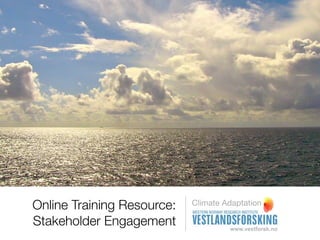
Online Training Resource for Climate Adaptation: Stakeholder engagement
- 1. Online Training Resource: Climate Adaptation Stakeholder Engagement
- 2. Stakeholder Engagement A Stakeholder is anyone with a vested interest in a particular action, decision and outcome. They can be individuals or a community or sector representatives. Stakeholder Engagement is the process by which stakeholders are involved and brought together to discuss and direct efforts toward a specific outcome. The process and nature of the engagement is very much determined by the project goals. For example, a simple, uncontroversial project may only require a ‘fact sheet’ and brief public meeting. A more contentious or long-term project, however, may need greater collaboration and involved time being invested to cultivate a deeper rapport and relationship with stakeholders. A such, a stakeholder ‘ladder of involvement’ can be drawn up. Climate Adaptation Online Training Resource
- 3. Stakeholder Engagement Ladder of Engagement Much can be said regarding how much involvement is “good”, and many methods and handbooks are developed to describe this issue (cf. two examples). The important thing here is to remember to address the question “how much?” (and “how?”). The “levels of involvement” • Informing: Citizens and stakeholders are only informed about (planned) activities by politicians and decision makers, but cannot influence the planning process; • Consultation: Decision makers seek discussion with citizens, the results however don’t consist of any commitment from the official side; • Advise: Citizens may develop solutions and report problems to decision makers. Their input will be considered by the decision makers, they, however, still have the final decision; • Co-produce: Decision makers and citizens jointly agree on issues to be solved and adequate solutions. The decision makers commit themselves to these solutions; • Co-decide: Decision making bodies leave the policy planning to the citizens and only keep an advisory role. The results, however, need to be in-line with certain preconditions (policy framework). Source: http://www.halton.gov.uk/sit/section1haltonversionoftoolkit.pdf Source: http://www.aeneas-project.eu/docs/AENEAS_StakeholderInvolvementHandbook.pdf Climate Adaptation Online Training Resource
- 4. Stakeholder Engagement In this training resource relevant points and examples of stakeholder engagement are provided at the end of each process stages. This has been done to highlight areas of concern and examples of good practice for each of the process stages. Here is a brief overview of 9 key principles in effective stakeholder engagement, as drawn up by Gardner et al. in their framework for stakeholder engagement on climate adaptation produced as part of the CSIRO research flagship series. 1. Scan for current or prior engagement work: Prior positive experiences can help promote engagement, prior negative experiences can retard engagement, and current activities of other groups can confuse participants or cause mutual interference. 2. Set goals and plan: Spend time clarifying what you want to achieve from the engagement process. Adding a discussion of climate adaptation into existing engagement groups may be an efficient approach. 3. Define the stakeholders: Use a range of local individuals and existing networks to recruit as wide a range of stakeholders as possible, but focus attention on those who are most willing and those who are most influential. 4. Manage expectations: Establish up-front where there is potential for participants to influence outcomes and where there is not. Allowing unrealistic expectations to develop amongst participants is very likely to cause problems later on. Climate Adaptation Online Training Resource
- 5. Stakeholder Engagement 5. Use group discussion: It is important to use a range of engagement forums, but group discussion is particularly important to enable the “high quality conversations” which allow people to develop a more complex understanding of the issue at hand. 6. Use varied presentation formats: Information should be presented in a range of different ways to accommodate the range of learning styles and needs in the community. Complex or difficult information should be presented in plain English and face to face. 7. Allow for mutual influence: Participants should have the opportunity to have input into decisions (as opposed to just being told what to do or just being asked to identify issues). 8. Foster trust, respect and ownership: Ideally, all parties to the engagement process should trust each other, respect one another’s viewpoint and inputs, and should gain a sense of personal responsibility towards the issue. Having experienced facilitators from a trusted agency to conduct the engagement is extremely useful to help promote these features. 9. Maintain contact and feedback: On long-term projects it is important to maintain regular contact with participants. People become cynical about engagement if decision makers do not communicate how participants’ input and suggestions were taken into account. Gardner, J., Dowd, A-M., Mason, C. and Ashworth, P. (2009). A framework for stakeholder engagement on climate adaptation. CSIRO Climate Adaptation Flagship Working paper No.3. http://www.csiro.au/resources/CAF-working-papers.html Climate Adaptation Online Training Resource
Editor's Notes
- \n
- \n
- \n
- \n
- \n
